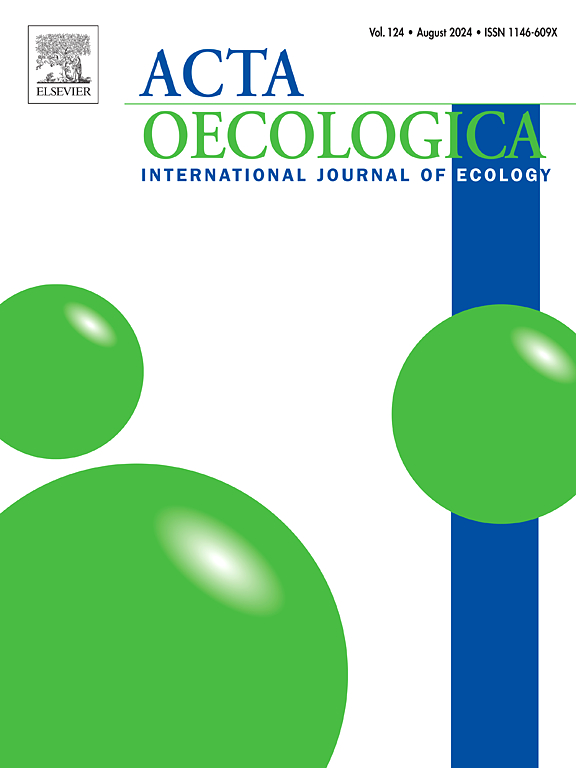欧洲块茎、黑孢块茎及其外生菌根树伙伴的最佳生态位分布向北移动
IF 1.3
4区 环境科学与生态学
Q3 ECOLOGY
Acta Oecologica-International Journal of Ecology
Pub Date : 2025-01-22
DOI:10.1016/j.actao.2025.104057
引用次数: 0
摘要
松露是一种有价值的食用菌,它与树木形成一种外生菌根共生关系,因此它们的分布取决于合适的树木伙伴的存在。全球变暖威胁到地中海盆地的松露和树木,因此该地区松露种植的未来。本文旨在预测气候变化下黑孢块茎(Tuber melanosporum)、黑孢块茎(T. aestivum)及其伴生树在欧洲的潜在分布。我们比较了分布广泛的松露树种(栎、榛)、地中海地区常见的松露树种(Q.ilex、Castanea sativa)和美国松露果园使用的非本地树种(山核桃)的结果。我们使用来自GBIF和文献的分布数据。利用MaxEnt模型,基于19个生物气候变量、树木分布数据和气候变化情景A1b、A2a和B2b,构建了2020 - 2080年气候变化相关的物种分布模型。我们预测未来松露生态位和树木的分布将向北转移,南欧松露生态位面积将大幅减少,中欧和北欧的松露生态位面积将大幅增加。在被测试的物种和气候情景中,这种总体趋势是普遍的。外生菌根树的分布是对松露最重要的预测因子。在气候变量中,最冷季降水、温度季节性和年平均温度的影响最大。由于全球变暖的后果严重威胁到南欧的松露及其树木伙伴,但在更北的地区为这些物种创造了新的气候生态位,我们建议松露的种植应该随着气候变化的模式向北移动。本文章由计算机程序翻译,如有差异,请以英文原文为准。
Northward shifting in the distribution of optimal niches for Tuber aestivum, Tuber melanosporum, and their ectomycorrhizal tree partners in Europe
Truffles are valuable edible fungi, which form an ectomycorrhizal symbiosis with trees, thus their distribution depends on the presence of appropriate tree partners. Global warming threatens truffles and trees in the Mediterranean Basin, hence the future of truffle cultivation in this region.
We aimed to predict the potential distribution of Tuber melanosporum, T. aestivum, and their tree partners in Europe under changing climate. We compared the results obtained among widespread (Quercus robur, Corylus avellana), common in the Mediterranean region (Q.ilex, Castanea sativa), and non-native tree used in truffle orchards in the United States (Carya illinoinensis). We used distribution data from GBIF and literature. Using MaxEnt models, we prepared species distribution models related to climate change between 2020 and 2080 based on 19 bioclimatic variables, distribution data of trees, and climate change scenarios A1b, A2a, and B2b.
We predicted a northward shift in the future distribution of niches for truffles and trees, a major decrease in the area of niches for truffles in southern Europe, and a substantial increase in central and northern Europe. The general trend was common for tested species and climatic scenarios. The distribution of ectomycorrhizal trees was the predictor of highest importance for truffles. Among climatic variables, precipitation of coldest quarter, temperature seasonality, and annual mean temperature contributed the highest importance.
Because the consequences of global warming seriously threaten truffles and their tree partners in southern Europe but generate novel climatic niches for these species in regions situated further north, we suggest that cultivation of truffles should be moved northward along with patterns of climate change.
求助全文
通过发布文献求助,成功后即可免费获取论文全文。
去求助
来源期刊
CiteScore
3.60
自引率
0.00%
发文量
57
审稿时长
>0 weeks
期刊介绍:
Acta Oecologica is venue for the publication of original research articles in ecology. We encourage studies in all areas of ecology, including ecosystem ecology, community ecology, population ecology, conservation ecology and evolutionary ecology. There is no bias with respect to taxon, biome or geographic area. Both theoretical and empirical papers are welcome, but combinations are particularly sought. Priority is given to papers based on explicitly stated hypotheses. Acta Oecologica also accepts review papers.

 求助内容:
求助内容: 应助结果提醒方式:
应助结果提醒方式:


